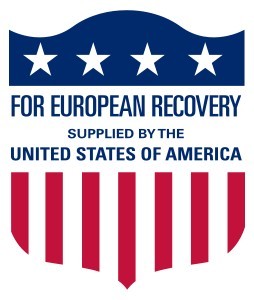

The Marshall Plan (officially the European Recovery Program, ERP) was the American program to aid Europe, in which the United States gave economic support to help rebuild European economies after the end of World War II in order to prevent the spread of Soviet Communism.[1] The plan was in operation for four years beginning in April 1948.[2] The goals of the United States were to rebuild a war-devastated region, remove trade barriers, modernize industry, and make Europe prosperous again.[3] The term "equivalent of the Marshall Plan" is often used to describe a proposed large-scale rescue program.[4]
The initiative [5] was named after Secretary of State George Marshall. The plan had bipartisan support in Washington, where the Republicans controlled Congress and theDemocrats controlled the White House. The Plan was largely the creation of State Department officials, especially William L. Clayton and George F. Kennan, with help from Brookings Institution, as requested by Senator Arthur H. Vandenberg, chairman of the Senate Foreign Relations Committee.[6] Marshall spoke of urgent need to help the European recovery in his address at Harvard University in June 1947.[3][7]
The reconstruction plan, developed at a meeting of the participating European states, was established on June 5, 1947. It offered the same aid to the Soviet Union and its allies, but they did not accept it,[8][9] as to do so would be to allow a degree of US control over the Communist economies.[10] During the four years that the plan was operational, U.S. $15 billion in economic and technical assistance was given to help the recovery of the European countries that had joined in the Organization for European Economic Co-operation. This $15 billion was in the context of a U.S. GDP of $258 billion in 1948, and was on top of $15 billion in American aid to Europe between the end of the war and the start of the Plan that is counted separately from the Marshall Plan.[11] The Marshall Plan was replaced by the Mutual Security Plan at the end of 1951.[12]
The ERP addressed each of the obstacles to postwar recovery. The plan looked to the future, and did not focus on the destruction caused by the war. Much more important were efforts to modernize European industrial and business practices using high-efficiency American models, reducing artificial trade barriers, and instilling a sense of hope and self-reliance.[13]
By 1952, as the funding ended, the economy of every participant state had surpassed pre-war levels; for all Marshall Plan recipients, output in 1951 was at least 35% higher than in 1938.[14] Over the next two decades, Western Europe enjoyed unprecedented growth and prosperity, but economists are not sure what proportion was due directly to the ERP, what proportion indirectly, and how much would have happened without it. A common American interpretation of the program's role in European recovery is the one expressed by Paul Hoffman, head of the Economic Cooperation Administration, in 1949, when he told Congress that Marshall aid had provided the "critical margin" on which other investment needed for European recovery depended.[15] The Marshall Plan was one of the first elements of European integration, as it erased trade barriers and set up institutions to coordinate the economy on a continental level — that is, it stimulated the total political reconstruction of western Europe.[16]
Belgian economic historian Herman Van der Wee concludes the Marshall Plan was a "great success":
"It gave a new impetus to reconstruction in Western Europe and made a decisive contribution to the renewal of the transport system, the modernization of industrial and agricultural equipment, the resumption of normal production, the raising of productivity, and the facilitating of intra-European trade."



















